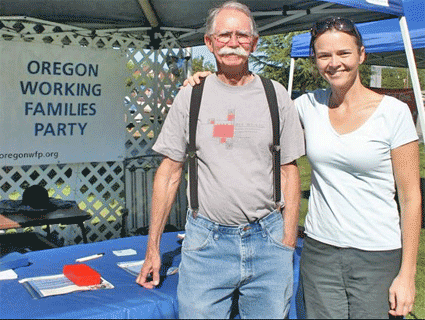
A Working Families Party table at the Winston Melon Festival in southern Oregon<a href="http://www.facebook.com/photo.php?fbid=436033839673&set=a.436033834673.217902.316589884673&type=3&theater">Oregon Working Families Party</a>/Facebook
In recent years, Oregon state Rep. Mike Schaufler spent some $6,000 from his campaign coffers on more than 90 separate visits to Magoo’s Sports Bar in Salem. A five-term Democrat known around the capitol as “Bud Man,” Schaufler was tight with Republicans and corporate donors, who helped him raise 60 percent more money than progressive challenger Jeff Reardon in the lead-up to last Tuesday’s Democratic primary. So Schaufler must have awoken with an epic hangover on the morning after the election, because he somehow managed to lose his seat.
Reardon, a high school teacher with limited resources and minimal political juice, says he never could have dispatched such a powerful incumbent were it not for the help of a relatively new political force in Oregon: the Working Families Party. Since its founding in New York 14 years ago, the WFP has expanded into four other states and logged a string of high-profile political victories—from reforming New York’s drug laws to providing the extra votes needed to clinch the election of Connecticut Gov. Dan Malloy, a liberal leader in a fairly moderate state. Many progressives believe the WFP could eventually become the left’s answer to the tea party.
“They are extremely valuable allies, and they are one of the most effective progressive political organizations I know,” Adam Ruben, political director of MoveOn.org, told me in an email. “The WFP has a model for building progressive political power that’s outside the Democratic Party. The Reardon race shows how it can work, and we need more of it.”
Unlike the better-known third parties such as the Greens or the Libertarians, who tend to field their own extremely long-shot candidates, the Working Families Party typically endorses like-minded Democrats and campaigns on their behalf. The five states in which it operates (New York, Connecticut, South Carolina, Vermont, and Oregon) all have enacted “fusion voting”—a system in which each party that qualifies gets a spot on the ballot—in some states its own line with a check box—where it can list the candidate it favors, regardless of party. (For instance, New York City mayor Michael Bloomberg, who ran for reelection as an independent, appeared on the GOP’s ballot line.) “That is an incredibly valuable piece of real estate,” says Steve Hughes, director of WFP’s Oregon chapter, which convinced state legislators to establish fusion voting in 2009. “It serves as a stamp of approval.”
The Working Families Party was founded in 1998 by labor unions and community groups that were upset by the rightward shift of the Democratic Party. It made a name for itself that year by garnering 50,000 gubernatorial votes on its ballot line for Democratic candidate Peter Vallone—enough to ensure the party a place on future ballots. (To get on the ballot in the first place, a registered party must collect a given number of petition signatures.)
In the following years, the WFP elected a raft of progressives to the New York City Council, including one of its own, Letitia James—the first third-party candidate in 30 years to win a council seat. In 2010, the party’s ballot line delivered nearly 200,000 votes to Democratic New York State Comptroller Tom Dinapoli—not an enormous number for a statewide race, but enough for the WFP to be taken seriously.
But the WFP is perhaps best known for pushing legislation, including a recent Connecticut bill requiring employers to offer paid sick leave. “They had a big impact,” says Chris Donovan, Connecticut’s speaker of the House, who is running for Congress this year with support from the WFP. “They were a real boost to providing energy to the campaign, and not only convincing people it was a good idea but also electing people who would support it. Both things have to happen for a bill of that magnitude to pass.”
In many respects, the WFP is a hybrid of a traditional third party and a group like MoveOn.org; in addition to rallying behind legislation and throwing its weight to candidates, it builds grassroots campaign operations at the local and state levels, and nurtures a farm team of progressive contenders. The party played a leading role in the Reardon-Schaufler race, bringing in support from its union members and enlisting its own paid canvassing and phone banking operations. It later convinced MoveOn to pile into the race with a fresh shot of volunteers, fundraising, and online organizing.
In the wake of the Supreme Court’s Citizens United decision, WFP organizers argue that progressives can be more effective in state and local races than congressional contests. The Oregon Legislature, for instance, is evenly split between Republicans and Democrats, and Schaufler would often cross the aisle on key votes. Yet his district was too small to win using mailers and TV ads; only about 4,000 people even bothered to cast ballots. “It was the kind of race where strategically speaking, a party such as ours knocking on doors and making a lot of phone calls could have a lot of impact,” Hughes says.
As with any political party, the WFP has its share of dissent from within the membership. For instance, the Service Employees International Union Local 32BJ, representing 120,000 workers in eight Eastern states, has sometimes supported candidates the party opposes. But Alison Hirsh, the union’s political director, calls the WFP “one of our most important political allies when it comes to moving our political agenda forward.” For one thing, the party gives union members the chance to work on issues too large for the union to tackle itself. And it gives everyday citizens a way to get involved and take leadership roles.
Given the WFP’s community roots and support for “99 percent” issues like New York’s “millionaires tax,” it was perhaps inevitable that the party would have some crossover with Occupy Wall Street. WFP organizer Nelini Stamp has played a big role in the Occupy movement, particularly its anti-bank and anti-foreclosure campaigns, and while some occupiers view the party with suspicion, others see it as the closest thing to the movement’s electoral arm. The success of the party, says Oregon WFP director Hughes, will ultimately depend on the degree to which it is seen as “a legitimate and effective expression of social-movement organizing.”
So can the WFP further expand its reach? Party leaders believe that the success of the tea party movement shows that they can—and without waging costly campaigns to enact arcane voting laws. In Oregon, which has closed primaries, the party didn’t appear on the Reardon-Schaufler ballot, yet it clearly affected the outcome. “What the WFP has done a decent job of is learning how to build a cohesive and durable coalition that then injects itself into primaries against corporate Democrats,” says New York WFP director Dan Cantor. “The main obstacle is: Do we have the talent? Do we have the resources?”
















